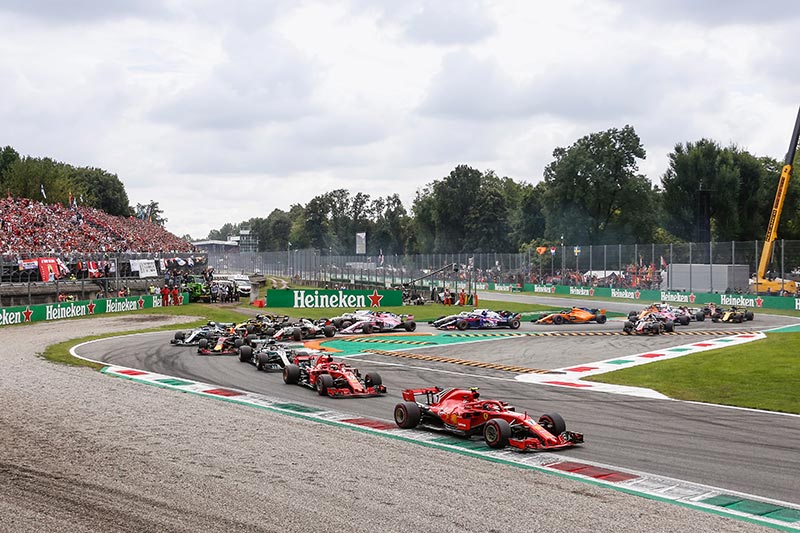The Autodromo Nazionale Monza, commonly known as the Monza Circuit, is regarded by many as the most legendary and iconic racetrack in Formula One history. As the host of the Italian Grand Prix for over 70 years, Monza has cemented itself as the true “Temple of Speed” through its flat-out straights, challenging corners, and rich racing heritage spanning nearly a century.
The Origins of the Monza Circuit
Construction on the Monza Circuit began in 1922 at the site of the Royal Villa of Monza, a former royal palace complex. The track was built in just 110 days, opening on September 3rd of that year. Monza was only the third purpose-built racetrack in the world at the time, following Brooklands in England and the Indianapolis Motor Speedway in the United States.
The original circuit combined a 5.5 km road course and a steeply banked oval track measuring 4.5 km in length. This high-speed oval allowed cars to sustain speeds over 180 km/h through its banked turns. The first Italian Grand Prix took place at Monza in 1922 on a 10 km combined layout.
The Deadly Years and Ensuing Safety Changes
During the pre-war era, Monza gained notoriety for a number of fatal crashes involving both drivers and spectators. The 1933 Monza Grand Prix saw three deaths, including drivers Giuseppe Campari and Count Baconin Borzacchini. This tragedy would be dubbed “The Black Day” of Monza.
Many changes were subsequently made to improve safety and reduce speeds at the circuit. The dangerous banked oval was abandoned altogether in 1938. Over the following decades, more chicanes were added and corner profiles were altered. Though this succeeded in slowing the cars, it did little to reduce the number of driver fatalities in the 1950s and 60s. Stirling Moss famously dubbed Monza “the most dangerous circuit in the world” during this period.
Finding the Right Balance of Speed and Safety
Further safety modifications were carried out through the 70s and 90s, balancing the need for slower cornering speeds while preserving Monza’s long straights. The resulting layout has remained largely unchanged since 2000, maintaining that balance between high speed and safety.
The updated Monza may be safer, but racing there is no less demanding. With its low downforce setup and emphasis on engine power, it remains the ultimate test of man and machine.

Memorable Monza Moments
The Closest Finish in History
The 1971 Italian Grand Prix featured the closest finish in Formula One history. After 54 laps, Peter Gethin took the win by a margin of just 0.01 seconds over Ronnie Peterson. The top five finishers were separated by a mere 0.61 seconds, emphasizing how critical every fraction of a second mattered that day.
First Wet Race Victory
The 2008 Italian Grand Prix saw Sebastian Vettel, then just 21 years old, claim his maiden Formula One victory in wet conditions. Having started from pole position, Vettel managed his tires and contended with the slippery circuit to take the first of many wins in his stellar career.
Ferrari’s First Home Victory in Nine Years
The legendary Scuderia Ferrari team endured a miserable drought at their beloved home circuit for nearly a decade. But in 2019, the passionate Tifosi finally had reason to celebrate as Charles Leclerc led Ferrari back to victory at Monza. The sea of red filling the grandstands erupted in elation to see Ferrari return to the top step at their spiritual home.
Why is Monza so Iconic?
Sheer Speed
With its long straights and fast corners, Monza allows Formula One cars to reach truly staggering speeds. At 375 km/h, the track consistently produces some of the highest top speeds on the calendar. Drivers spend nearly 75% of the lap at full throttle, putting immense strain on engines.
Historic Significance
Having hosted every Italian Grand Prix since 1948 with only one exception, Monza holds a special place in Formula One lore. Legends from Fangio to Clark to Schumacher built their legends here across seven decades of racing.
The Fans
No discussion of Monza is complete without the Tifosi. The sea of red passion surrounding the circuit creates an atmosphere like no other race. Winning the Italian Grand Prix, especially for Ferrari, means everything to this devoted fanbase.
With its rich history, stunning speeds, and captivating ambiance, it is no wonder the Monza Circuit has earned a reputation as the most revered track in Formula One.
The Future of the Temple of Speed
Rumors have swirled for years around potential F1 calendar changes that could threaten Monza’s place. But the historic circuit signed a new deal in 2022, securing the Italian Grand Prix through 2025. The Temple of Speed shall continue welcoming the fastest cars and most ardent fans in motorsport for years to come.
Monza has evolved across nine decades of Grand Prix racing, but its character remains untouched. As long as Formula One exists, the Temple of Speed will stand as hallowed ground for drivers and fans alike.

